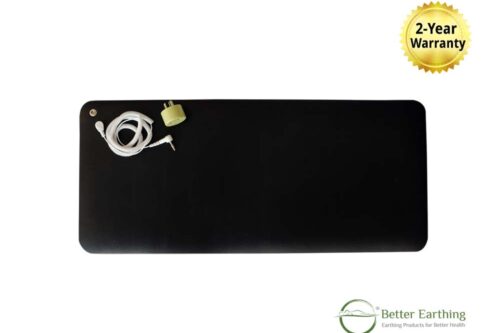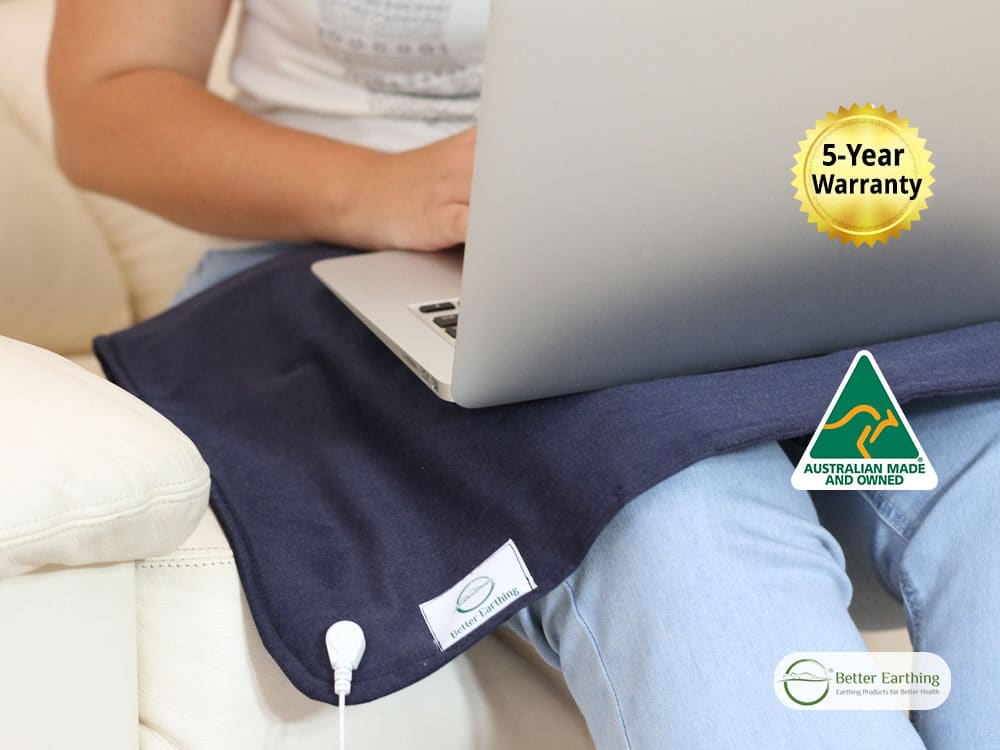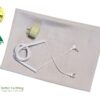Earthing for Arthritis Relief

Finding effective arthritis relief can be a challenge.
If you’ve been diagnosed with osteoarthritis, rheumatoid arthritis, psoriatic arthritis or gout. you may already be using a combination of lifestyle changes, alternative medicine and/or pain medication to relieve arthritis pain and boost your body’s healing ability.
Earthing or grounding is a newer holistic approach that may offer temporary and long-term relief of arthritic pain.
It helps reduce inflammation, improve blood flow, and promote restorative sleep, all of which are helpful for arthritis sufferers.
It equalises your body’s electrical potential with the earth, which has a slight negative charge.
The earth’s surface is rich in free electrons, which are created by solar energy and lightning strikes. These free electrons enter our body when we walk barefoot on the grass or use an indoor product that passes or conducts free electrons from the ground outside into our body.
There are over twenty published research studies on grounding. While many are pilot studies, when taken together, they show promise for multiple health conditions especially those related to inflammation.
You can read case studies on this website from people who have found relief from osteoarthritis pain and rheumatoid arthritis pain. Their experiences range from to long-term reduction of
If you are taking for , it is a good idea to talk to your doctor before adding a new approach, even if it’s completely natural like grounding.
Inflammatory Response
A healthy immune system creates a short-lived, inflammatory response to injury or infection when it summons specialized white blood cells to destroy or remove pathogens, such as bacteria and viruses.
This surge of activity gives off a large amount of heat. The familiar symptoms of swelling, redness, and pain quickly follow.
In chronic inflammation, this inflammatory process keeps going. The body becomes too sensitive to harmless substances. Worse still, it can fail to recognize the body’s tissues and begin to attack them.
Inflammatory arthritis such as rheumatoid and psoriatic arthritis is caused by an overactive inflammatory response. The body’s antibodies attack the lining of the joints, causing pain, and in some cases deformity. To stop this cycle, rheumatoid arthritis medications aim to modify the body’s immune response.
In osteoarthritis, inflammation is a byproduct of the degeneration of the joint, not the cause.
In a healthy joint, rubbery material called cartilage at the end of the bone provides a smooth cushion that allows for easy movement. When the cartilage breaks down, pain, swelling, stiffness, and immobility can result.
If ongoing, the cells in the bone may develop a nodule or bone spur. This tends to happen in joints or discs in the spine with prolonged information and degenerated cartilage. While some bone spurs do not cause any pain at all, others can be painful due to pressure on surrounding nerves or tendons. Occasionally surgery may be needed.
Medical Treatment
Many arthritis medications aim to reduce inflammation.
In the case of rheumatoid arthritis, they work by dampening the immune response. While for osteoarthritis, medications are typically anti-inflammatories. Surgery is also an option.
Medications for Rheumatoid Arthritis
There are three main types of rheumatoid arthritis medications: corticosteroids, disease-modifying drugs, and biological drugs.
Corticosteroids, like prednisolone, are usually prescribed as a short course. Long term, they can produce serious side effects including:
- Weight gain
- Thinning of the bones or skin
- High blood pressure
- Cataracts
- Stomach pain, nausea, or gastric bleeding
- Lowered immunity and higher risk of infections
Disease-modifying drugs, for example, methotrexate, affect the immune system and reduce inflammation. Side effects include:
- Liver damage
- Reduced production of red blood cells
- Lung, intestine, or stomach damage
The newest class of drugs for rheumatoid arthritis relief are the biologic drugs. These include adalimumab and etanercept. Again, these reduce inflammation by calming the immune system. Side effects include:
- Lowered immunity and increased risk of infection
- Flu-like symptoms
- Fatigue
If you are currently taking prescription rheumatoid arthritis medications, then stopping suddenly may cause side effects. Instead, consult with your doctor on combining natural options with medication or find a holistic GP to collaborate with on your health strategy.
Medications for Osteoarthritis
The most commonly prescribed anti-inflammatory drugs for osteoarthritis are non-steroidal anti-inflammatories NSAID. These include ibuprofen, naproxen, and diclofenac. They are safe for most people. However, asthmatics, people suffering from cardiovascular disease, and people with gastric problems should exercise caution. The main side effect of NSAIDs is that they irritate the stomach lining. This can be avoided by taking them after food. Other side effects include:
- Gastrointestinal bleeding and ulcers
- Increased risk of stroke or heart attack
- Kidney damage
Other painkillers can also be used, although they do not have the effect of reducing inflammation. When taken properly, paracetamol is the safest option as it is well tolerated by most people and available over the counter. Stronger painkillers that contain an opioid such as codeine may be prescribed if necessary. The side effects of opioids include:
- Drowsiness
- Dizziness
- Nausea
- Constipation
- Risk of dependence
- Risk of overdose
Like rheumatoid arthritis, osteoarthritis can be treated using corticosteroid drugs to reduce inflammation. These can be taken orally or injected into a specific joint to reduce the risk of side effects.
Osteoarthritis can also be treated surgically. Arthroscopy is a minimally invasive surgical procedure in which a small tool is used to repair damaged joints and cartilage. A whole joint replacement may be needed if the damage is severe. Knee or hip joint replacements are the most common, followed by ankle, wrist, and shoulder.
Natural Pain Relief for Arthritis
Many people prefer to use natural pain relief for arthritis, either to reduce the need for medication or to complement its effects.
Therapies such as physiotherapy, osteopathy, acupuncture, and massage are all helpful in managing stiffness and pain. Mindfulness and meditation techniques relax the body and mind, reduce stress, and manage the pain associated with rheumatoid or osteoarthritis.
At home, applying hot or cold compresses can help to relieve arthritis pain. Experiment with both to find out which works best for you.
Exercise is another simple yet effective way to provide relief from arthritis symptoms. Gentle, low-impact exercises strengthen the muscles, keep the joints mobile, and relieve stiffness. Yoga, tai chi, and swimming are especially suitable.
Another way to manage arthritic pain is by making adjustments to your diet or taking supplements. Two of the most well-known are turmeric and ginger. As spices, these can be easily incorporated into meals, and research supports their efficacy for pain relief.
Fish oil and other omega 3s have also been found to reduce joint inflammation in rheumatoid and other forms of inflammatory arthritis. However, it often takes 2-3 months for any noticeable effect and concentrated forms are often needed for sufficient dosage. Speak to your doctor first before introducing it, especially if you are currently taking prescription medicines.
Earthing for Arthritis Relief
Earthing is the act of being in conductive contact with the earth. You can do it by walking outside barefoot on green grass or by bringing yourself into conductive contact with an indoor earthing product. Find out more in What is Grounding.
The idea of earthing is fairly new, but one with ancient roots. Before the advent of rubber-soled shoes and high-rise living, people lived closer to the earth. They wore leather shoes or walked barefoot. They spent more time outside and grew their food. This allowed for close, conductive contact with the earth’s subtle negative charge.
The earth’s surface is rich in what are known as free electrons. These are formed by solar energy and lightning strikes. In the body, these free electrons have been found to reduce inflammation, improve blood flow, and relieve pain.
Over twenty published research studies have been done on earthing. None have addressed arthritis as yet, despite growing anecdotal reports on temporary relief and long-term reduction of joint inflammation and pain with earthing. Read testimonials relating to earthing and osteoarthritis or rheumatoid arthritis.
Earthing for Relief
Earthing has been found to provide the body with additional antioxidants to wind up inflammatory processes faster.
A 2010 study explored the effects of earthing on several different biological markers including levels of white blood cells.
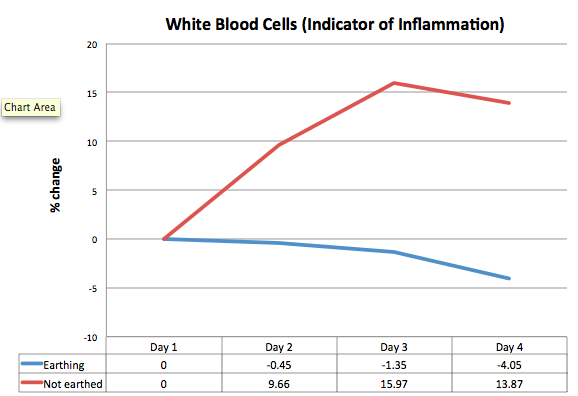
Earthing reduced inflammatory markers faster after injury in earthed subjects compared to those who were sham-earthed. The earthed subjects also reported less pain.
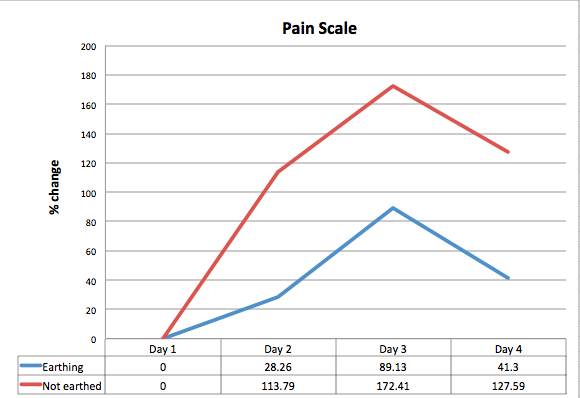
Testing took place over four days when the subjects slept on an earthing sleep system overnight, plus did 40minutes on a grounding mat after exercising at the same time each day. While the subjects in this study were athletic, healthy, individuals, the following case studies looked at people in pain.
Dr William Amalu conducted 20 case studies on a diverse range of people in pain. He found that the use of targeted earthing on the affected area and/or sleeping earthed overnight had reduced inflammation and pain levels. Some of the experiences were remarkable.
One person with chronic knee pain had an immediate result after 30 minutes of earthing. In the prior 6 years, she had received 3 knee surgeries and extension physical therapy with poor results. Her knee pain was triggered by a fall from a ladder.

The red, orange, and yellow colours of the left-hand image show soreness and heat before earthing.
The right-hand side is after 30 minutes of earthing directly to each knee. It shows a significant reduction in inflammation after 30 minutes – note the cooler colours. The subject reported a 20% reduction in pain that lasted 24 hours. She followed this up with regular daily earthing and continued to experience increasing pain relief.
Other case studies had similar results. The thermal imagery for case study 14 below shows pictures taken before earthing (left) and after 4-weeks of daily earthing (right). Note the reduction of inflammation behind the right knee shown as a return to cooler colours, and the symmetry between left and right legs. The subject reported a 70% reduction in pain after 4-weeks of regular daily earthing to the knee joint.
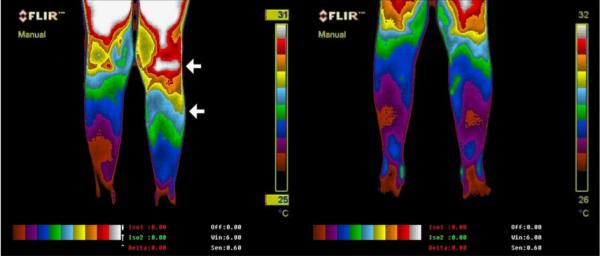
Improving Blood Circulation
Having better blood flow is another way in which earthing may help relieve arthritis symptoms.
Blood is made up of white cells, red cells, platelets (which help with clotting), other chemicals, and gases, all suspended in a liquid called plasma.
When the plasma has a high concentration of red cells, blood viscosity or stickiness increases. This means it does not flow as smoothly.
This increases the risk of cardiovascular disease. Poor blood flow reduces the rate at which nutrients and oxygen are delivered to the organs and muscles. Poor circulation is often a factor in painful conditions such as arthritis.
Earthing reduces blood viscosity by preventing red blood cells from clumping together, as shown in this 2013 study. All of the participants who presented with pain reported a reduction after two hours of earthing.
The Importance of Good Sleep
The relationship between pain and disrupted sleep is well established.
Being unable to get comfortable at night or being woken by joint pain can result in a vicious cycle of poor sleep and increased arthritis pain during the day. One theory is that the body’s circadian rhythms contribute to this.
Cortisol, a powerful natural anti-inflammatory produced by the adrenal glands, is typically at its lowest around midnight. While melatonin production increases, it can increase the amount of circulating inflammatory cytokines aiming to clean out any pathogens from the body. Unfortunately, this can also mean increased arthritis symptoms.
Grounding Overnight for Deep Sleep and Pain Relief
Sleeping on an earthing underlay can help you return to good sleeping patterns and relieve arthritis. Research has shown that earthing overnight can help restore or reset overnight cortisol levels so that are low at midnight and gradually rise in the morning.
Cortisol is a hormone produced by the adrenal glands. It peaks in the morning, which triggers the process of waking up from sleep. Although it is vital for health, having raised cortisol levels is associated with increased stress, inflammation, and pain. By reducing cortisol levels, earthing overnight may assist in arthritis symptoms.
Reduced Aches & Pains on Waking
Another common symptom of both rheumatoid and osteoarthritis is waking up sore in the morning. This is because when you sleep, certain proteins that reduce inflammation are inhibited. This results in greater stiffness and pain upon waking up.
Earthing yourself while you sleep may help. Participants in a small-scale study on grounding and sleep experienced reduced pain over 8 weeks of sleeping each night on an earthing sheet.
How to Get Started
To experience earthing, all you have to do is step outside and kick off your shoes. Just a few minutes standing barefoot on grass or unpainted concrete is enough to begin to take advantage of earthing’s many benefits.
You can also use an earthing product indoors. These allow you to combine earthing with another activity such as sleeping, working in an office, or reading a book. Browse the full range of products in our shop.
Read the Research
Oschman J, Chevalier G, Hill, M. ‘Pilot study on the effect of grounding on delayed-onset muscle soreness.’ Journal of Alternative Complementary Medicine. 2010 Mar; 16(3): 256-73.
Chevalier G, Sinatra ST, Oschman JL, Delany RM. ‘Earthing (grounding) the human body reduces blood viscosity—a major factor in cardiovascular disease.’ Journal of Alternative and Complementary Medicine, 2013, Volume 19 (2). 102-110
Amalu, W. Clinical Earthing Application in 20 Case Studies, unpublished research by Dr Amalu president of the International Academy of Clinical Thermography
